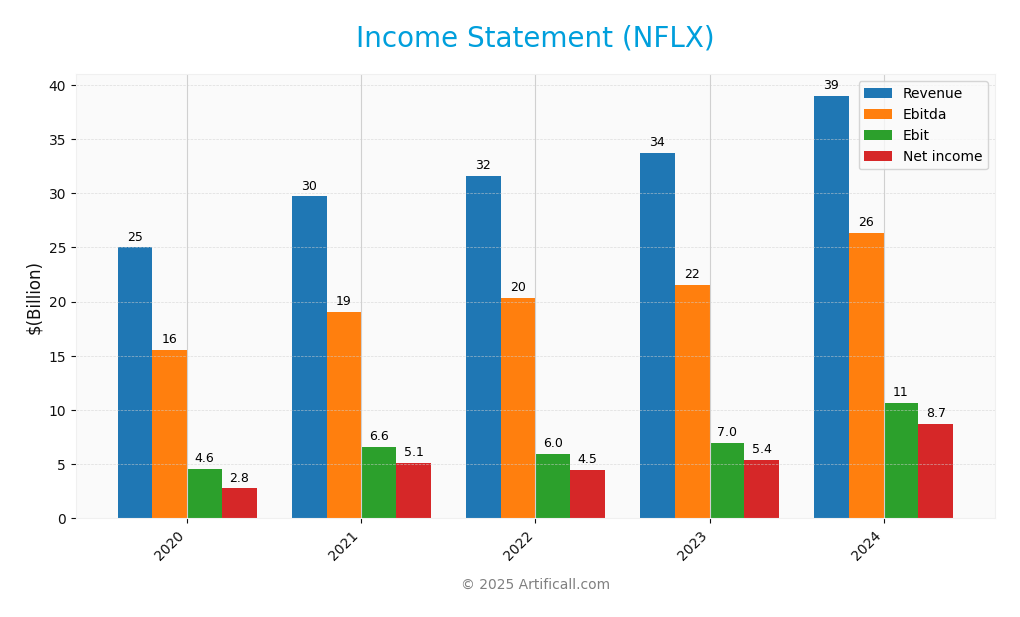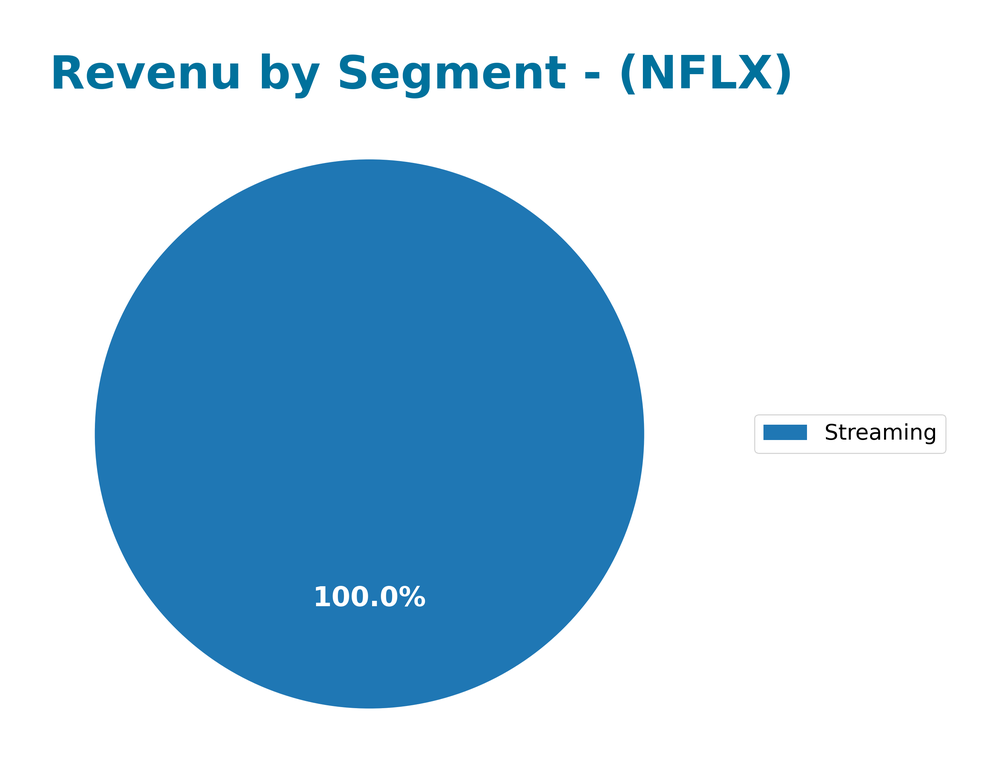Imagine a world where your entertainment options are limitless, transforming the way you unwind after a long day. Netflix, Inc. does just that, leading the entertainment industry with a dynamic library of TV series, films, and documentaries that cater to global audiences. Renowned for its innovative streaming technology and original content, Netflix has captivated over 222M subscribers in 190 countries. As we delve into this analysis, I invite you to consider whether Netflix’s impressive fundamentals still support its current market valuation and growth trajectory.

Table of contents
Company Description
Netflix, Inc. is a leading player in the entertainment industry, providing a vast array of streaming services that include TV series, documentaries, and feature films, alongside mobile games. Founded in 1997 and headquartered in Los Gatos, California, Netflix serves approximately 222M paid members across 190 countries. The company operates primarily in the online streaming segment, leveraging a robust technology platform to deliver content on various devices including TVs, smartphones, and tablets. With a market capitalization of $425B, Netflix has established itself as a pioneer in content delivery and consumption, continuously shaping industry standards through innovation and a strong focus on user experience.
Fundamental Analysis
In this section, I will analyze Netflix, Inc.’s income statement, financial ratios, and dividend payout policy to assess its financial health and investment potential.
Income Statement
The following table summarizes the income statement for Netflix, Inc. over the past five fiscal years, highlighting key financial figures that reflect the company’s performance.

| Financial Metrics | 2020 | 2021 | 2022 | 2023 | 2024 |
|---|---|---|---|---|---|
| Revenue | 25B | 29.7B | 31.6B | 33.7B | 39B |
| Cost of Revenue | 15.3B | 17.3B | 19.2B | 19.7B | 21B |
| Operating Expenses | 5.1B | 6.2B | 6.8B | 7.1B | 7.5B |
| Gross Profit | 9.7B | 12.4B | 12.4B | 14B | 17.9B |
| EBITDA | 15.5B | 19B | 20.3B | 21.5B | 26.3B |
| EBIT | 4.6B | 6.6B | 5.9B | 6.9B | 10.7B |
| Interest Expense | 1.4B | 0.4B | 0.7B | 0.7B | 0.7B |
| Net Income | 2.8B | 2.6B | 4.5B | 5.4B | 8.7B |
| EPS | 0.63 | 1.16 | 1.01 | 1.23 | 2.03 |
| Filing Date | 2021-01-28 | 2022-01-27 | 2023-01-26 | 2024-01-26 | 2025-01-27 |
Interpretation of Income Statement
Over the last five years, Netflix has shown a consistent upward trajectory in both Revenue and Net Income, with 2024’s Revenue reaching 39B, a notable increase from 33.7B in 2023. Gross Profit margins have improved, indicating effective cost management, while EBITDA growth reflects operational efficiency. In 2024, Net Income surged to 8.7B, signaling robust profitability. This performance suggests that Netflix is not only expanding its top line but also enhancing its bottom line through strategic management of expenses and revenue generation, although attention should be paid to the increasing operational costs relative to revenue growth.
Financial Ratios
Here is a summary of key financial ratios for Netflix, Inc. (NFLX) over the years:
| Ratio | 2020 | 2021 | 2022 | 2023 | 2024 |
|---|---|---|---|---|---|
| Net Margin | 11.05% | 17.23% | 14.21% | 16.04% | 22.34% |
| ROE | 24.96% | 32.28% | 21.62% | 26.27% | 35.21% |
| ROIC | 12.28% | 14.62% | 11.72% | 14.91% | 20.20% |
| P/E | 86.34 | 52.18 | 29.19 | 39.76 | 43.94 |
| P/B | 21.55 | 16.84 | 6.31 | 10.44 | 15.47 |
| Current Ratio | 1.25 | 0.95 | 1.17 | 1.12 | 1.22 |
| Quick Ratio | 1.25 | 0.95 | 1.17 | 1.12 | 1.22 |
| D/E | 1.67 | 1.14 | 0.81 | 0.82 | 0.73 |
| Debt-to-Assets | 47.12% | 40.63% | 34.84% | 34.83% | 33.55% |
| Interest Coverage | 3.31 | 8.09 | 7.98 | 9.29 | 14.49 |
| Asset Turnover | 0.64 | 0.67 | 0.65 | 0.69 | 0.73 |
| Fixed Asset Turnover | 26.03 | 22.44 | 22.61 | 22.61 | 24.47 |
| Dividend Yield | 0% | 0% | 0% | 0% | 0% |
Interpretation of Financial Ratios
Netflix, Inc. (NFLX) displays a mixed financial health profile as of FY 2024. The liquidity ratios, such as the current ratio (1.22) and quick ratio (1.22), indicate adequate short-term financial health, although a quick ratio below 1 could raise concerns. The solvency ratio (0.84) is strong, suggesting a solid ability to meet long-term obligations. Profitability is reflected in the net profit margin (22.34%) and return on equity (35.21%), indicating effective cost management and strong earnings. However, high valuation ratios like the price-to-earnings (43.94) and price-to-book (15.47) suggest overvaluation risks, which warrant caution for potential investors.
Evolution of Financial Ratios
Over the past five years, Netflix’s financial ratios show a general improvement in profitability and liquidity, with notable increases in net profit margin and current ratio. However, valuation ratios have consistently remained high, indicating persistent investor optimism despite the risks involved.
Distribution Policy
Netflix, Inc. (NFLX) does not pay dividends, opting instead to reinvest profits to fuel growth and enhance its content library. This strategy aligns with its high-growth phase, prioritizing R&D and acquisitions to drive long-term shareholder value. Notably, Netflix also engages in share buybacks, which can support share price appreciation. Overall, this approach appears to foster sustainable long-term value creation for shareholders, provided that growth metrics remain robust.
Sector Analysis
Netflix, Inc. is a leading player in the entertainment industry, known for its extensive streaming library and original content, facing competition from various streaming services.
Strategic Positioning
Netflix, Inc. (NFLX) holds a significant position in the global entertainment market, boasting a market capitalization of approximately $425B and around 222M paid subscribers across 190 countries. Despite its strong market share, the company faces intense competitive pressure from emerging streaming platforms and traditional media companies adapting to digital consumption. Technological disruptions, such as advancements in streaming technology and content delivery, continue to challenge Netflix’s business model. Maintaining innovation and diversifying content offerings will be crucial for sustaining its competitive edge in this rapidly evolving landscape.
Revenue by Segment
The following chart illustrates Netflix’s revenue from its primary segments, focusing on the fiscal years leading up to 2024.

Over the past few years, Netflix’s Streaming segment has consistently driven revenue growth, with figures rising from 25B in 2020 to 39B in 2024. The Domestic DVD segment, while still present, has seen diminishing returns, contributing only 83M in 2023. The most recent fiscal year shows a significant acceleration in Streaming revenue, reflecting a strategic focus on content and global expansion. However, the legacy DVD business continues to present margin risks as it contracts, highlighting the importance of adapting to evolving consumer preferences.
Key Products
Below is a summary of key products offered by Netflix, Inc., which underline the company’s position in the entertainment industry.
| Product | Description |
|---|---|
| Streaming Service | Netflix provides a subscription-based streaming service that offers a vast library of TV series, documentaries, and feature films across various genres and languages. Subscribers can access content on various devices, including smart TVs, smartphones, and tablets. |
| Original Content | The company invests heavily in original programming, producing exclusive movies and series, such as “Stranger Things” and “The Crown,” which attract and retain subscribers globally. |
| Mobile Games | Recently, Netflix has expanded into mobile gaming, offering subscribers access to a selection of games without additional fees, enhancing the overall entertainment experience. |
| DVDs-by-Mail Service | Although primarily focused on streaming, Netflix continues to provide a DVD rental service in the U.S., allowing members to receive physical DVDs through the mail. |
Main Competitors
The competitive landscape for Netflix, Inc. (NFLX) is characterized by several key players in the entertainment sector, each vying for market share in the streaming and media industry.
| Company | Market Cap |
|---|---|
| Netflix, Inc. | 425B |
| The Walt Disney Company | 190B |
| Warner Bros. Discovery, Inc. | 65B |
| Live Nation Entertainment, Inc. | 32B |
| TKO Group Holdings, Inc. | 16B |
| Warner Music Group Corp. | 15B |
| News Corporation | 15B |
| Madison Square Garden Entertainment | 2.4B |
| IMAX Corporation | 1.9B |
| Dave & Buster’s Entertainment, Inc. | 600M |
In summary, Netflix operates in a highly competitive environment with major players like Disney and Warner Bros. Discovery, particularly in the North American and global markets. This diverse competition underscores the importance of innovation and strategic content offerings in maintaining market leadership.
Competitive Advantages
Netflix, Inc. (NFLX) holds a strong competitive advantage in the streaming entertainment industry, primarily due to its vast content library and extensive subscriber base of approximately 222M across 190 countries. The company’s commitment to original programming and diverse content offerings positions it well for future growth. Upcoming opportunities include expanding into new markets and enhancing its mobile gaming portfolio, which may attract younger audiences. As streaming technology evolves, Netflix’s ability to innovate and adapt will be crucial to maintaining its leadership position in the market.
SWOT Analysis
The following SWOT analysis provides a clear overview of Netflix, Inc. and its strategic positioning in the entertainment industry.
Strengths
- Strong brand recognition
- Extensive content library
- Large global subscriber base
Weaknesses
- High content production costs
- Dependence on subscriptions
- Intense competition
Opportunities
- Expansion into new markets
- Growth in original content
- Partnerships with other platforms
Threats
- Rising competition from new entrants
- Regulatory challenges
- Economic downturns affecting subscriptions
The overall SWOT assessment indicates that while Netflix possesses significant strengths and opportunities, it must address its weaknesses and navigate potential threats to maintain its competitive edge. Strategic focus on content efficiency and market expansion will be crucial for sustained growth.
Stock Analysis
Over the past year, Netflix, Inc. (NFLX) has experienced significant price movements and trading dynamics, culminating in a notable bullish trend despite recent fluctuations.

Trend Analysis
Analyzing the stock’s performance over the last 12 months, NFLX has recorded a remarkable price change of +103.66%. This indicates a bullish trend trajectory for the stock. However, it’s worth noting that the trend is currently showing signs of deceleration, with volatility measured at a standard deviation of 24.37. The stock reached a high of 132.31 and a low of 48.3 during this period.
In contrast, the recent performance from September 21, 2025, to December 7, 2025, indicates a price decrease of -18.3%, which does not alter the long-term bullish sentiment but suggests short-term volatility and potential caution for investors.
Volume Analysis
In the last three months, the total trading volume for NFLX has been approximately 22.99B, with buyers accounting for about 54.85% of this volume. However, recent trends indicate a decrease in overall trading volume. The latest data shows that during the recent period, buyer volume was 895.25M, while seller volume reached 1.50B, indicating a seller-dominant market behavior with a buyer dominance percentage of only 37.44%. This selling activity suggests a cautious investor sentiment and may reflect uncertainty in the market regarding the stock’s short-term performance.
Analyst Opinions
Recent analyst recommendations for Netflix, Inc. (NFLX) show a consensus rating of “Buy.” Analysts, including those from major firms, highlight the company’s strong return on equity (score of 5) and return on assets (score of 5) as key strengths. However, they note concerns regarding its price-to-earnings and price-to-book ratios, both rated at 1. The overall score of 3 indicates a balanced view, suggesting that while Netflix has solid operational metrics, investors should remain cautious about valuation risks.
Stock Grades
Here’s a summary of the latest stock grades for Netflix, Inc. (NFLX), reflecting the opinions of several reputable grading companies.
| Grading Company | Action | New Grade | Date |
|---|---|---|---|
| Rosenblatt | maintain | Buy | 2025-11-28 |
| JP Morgan | maintain | Neutral | 2025-11-18 |
| Barclays | maintain | Equal Weight | 2025-11-18 |
| KGI Securities | upgrade | Outperform | 2025-11-03 |
| Canaccord Genuity | maintain | Buy | 2025-10-22 |
| Benchmark | maintain | Hold | 2025-10-22 |
| Wells Fargo | maintain | Overweight | 2025-10-22 |
| Needham | maintain | Buy | 2025-10-22 |
| Wedbush | maintain | Outperform | 2025-10-22 |
| Rosenblatt | maintain | Buy | 2025-10-22 |
Overall, the trend in Netflix’s stock grades shows a consistent preference for maintaining buy ratings, with a notable upgrade to “Outperform” by KGI Securities. This indicates a generally positive sentiment towards the stock, suggesting that many analysts see growth potential despite some neutral perspectives.
Target Prices
Analysts have established a consensus target price for Netflix, Inc. (NFLX), reflecting their expectations for the stock’s future performance.
| Target High | Target Low | Consensus |
|---|---|---|
| 1500 | 138 | 1206.54 |
Overall, the target prices suggest a strong bullish sentiment among analysts, indicating optimism for NFLX’s growth potential.
Consumer Opinions
Consumer sentiment towards Netflix, Inc. (NFLX) remains a mix of enthusiasm and critique, reflecting both the strengths of its content offerings and areas for improvement.
| Positive Reviews | Negative Reviews |
|---|---|
| “The variety of content is unmatched!” | “Subscription prices keep rising.” |
| “Original series are top-notch.” | “User interface can be confusing at times.” |
| “Great for binge-watching. Always something new!” | “Streaming quality can be inconsistent.” |
Overall, consumer feedback highlights Netflix’s impressive content library and original programming as major strengths, while concerns about rising costs and user experience persist as notable weaknesses.
Risk Analysis
In assessing the potential risks associated with investing in Netflix, Inc. (NFLX), I have compiled a table outlining the key categories, descriptions, probabilities, and impacts of various risks.
| Category | Description | Probability | Impact |
|---|---|---|---|
| Market Competition | Increased competition from streaming services. | High | High |
| Content Costs | Rising costs for acquiring and producing content. | High | High |
| Subscriber Growth | Slowing subscriber growth in saturated markets. | Medium | High |
| Regulatory Risks | Potential regulations impacting content distribution. | Low | Medium |
| Economic Downturn | Economic challenges affecting disposable income. | Medium | High |
The most pressing risks for Netflix include high competition and escalating content costs, both of which can significantly affect profitability and market share. Recent trends indicate that new entrants are increasingly capturing viewership, complicating NFLX’s growth trajectory.
Should You Buy Netflix, Inc.?
Netflix, Inc. (NFLX) has demonstrated strong profitability with a net income of 8.71B and a positive net profit margin of 22.34% for the fiscal year ending 2024. The company’s Return on Invested Capital (ROIC) of 20.20% exceeds its Weighted Average Cost of Capital (WACC) of 11.43%, indicating value creation. However, with total debt standing at 17.99B, the company’s debt-to-equity ratio of 0.727 suggests a moderate level of leverage. Overall, Netflix has received a rating of B, reflecting positive fundamentals but with some caution warranted in terms of debt management.
Favorable signals
I have identified several favorable signals for Netflix, Inc. The company has achieved a revenue growth of 15.65%, a gross margin of 46.06%, and a gross profit growth of 28.23%. Additionally, operating expenses have aligned with revenue growth, and the EBIT margin stands at 27.4% with an impressive EBIT growth of 53.64%. The net margin is positive at 22.34%, with net margin growth of 39.29% and EPS growth at 64.84%. Furthermore, the return on equity (ROE) is strong at 35.21%, indicating solid profitability.
Unfavorable signals
Despite the favorable aspects, there are notable unfavorable elements. The weighted average cost of capital (WACC) is 11.43%, which is higher than the return on invested capital (ROIC) of 20.2%, implying value destruction. The price-to-earnings (P/E) ratio is quite high at 43.94, and the price-to-book (P/B) ratio stands at 15.47, suggesting the stock may be overvalued. Additionally, the absence of a dividend yield is also unfavorable.
Conclusion
In summary, while the income statement evaluation is favorable and the overall ratios evaluation is also favorable, the presence of a higher WACC than ROIC indicates value destruction. Given the recent trend where seller volume exceeds buyer volume, it might be prudent to wait for buyers to return before making any investment decisions.
Disclaimer: This article is not financial advice. Each investor is responsible for their own investment decisions.
Additional Resources
- (NFLX) Netflix to Buy Warner Bros. in $72 Billion Cash, Stock Deal – Bloomberg.com (Dec 05, 2025)
- Netflix Nears Mega Warner Bros. Deal — Should You Buy NFLX Stock Now? – Yahoo Finance (Dec 05, 2025)
- Netflix: Sell After The Warner Bros Discovery Acquisition (NASDAQ:NFLX) – Seeking Alpha (Dec 05, 2025)
- Netflix Could Be About to Buy Harry Potter. Investors Aren’t Happy About It. – Investopedia (Dec 04, 2025)
- Netflix Stock Falls. Wall Street Is Worried About Warner Deal’s High Price and Debt. – Barron’s (Dec 05, 2025)
For more information about Netflix, Inc., please visit the official website: netflix.com



